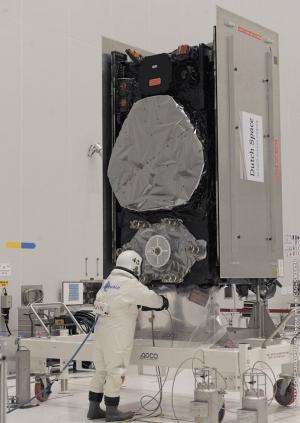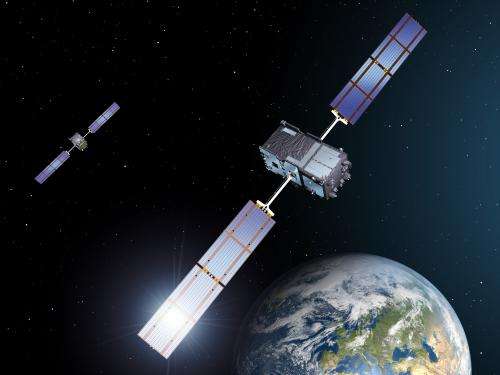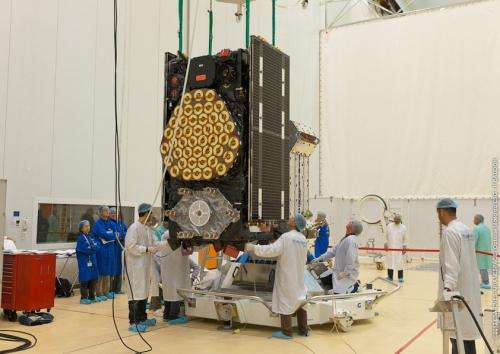Galileo FM3 in the clean room at Europe's Spaceport, French Guiana. The fuelling process has begun ahead of the next Galileo launch in early October 2012. Credit: ESA/CNES/Arianespace/Optique Video du CSG
The twin Galileo satellites are now fully fuelled and mated together atop the upper stage that will haul them most of the way up to their final orbit. The launch is now planned for the evening of 12 October.
Technicians donned protective suits to fill the two satellites' tanks with hydrazine fuel, used to maintain the satellites' attitude and orbital position during their planned 12-year lifetime.
Rather than carry a significant amount of extra fuel to insert themselves into their planned orbits – like typical telecommunications satellites or Galileo's US GPS equivalents – the Galileo satellites are transported to medium orbit by the Fregat fourth stage of their Soyuz ST-B launcher.
Doing without this extra fuel and orbital thrusters means that Galileo satellites are small enough to be launched in pairs aboard the Soyuz – or in fours by the new Ariane 5 variant currently being prepared.
The Galileo satellites are attached to a special dispenser that holds them securely in position during launch, before pyrotechnic mechanisms release them sideways in opposite directions once their set 23 222 km altitude is reached.
The first two of four Galileo In-Orbit Validation satellites were launched on 21 October 2011. Credit: ESA – P. Carril
The aluminium plates on each side of the satellites are temporary additions to protect their delicate solar panels; these will be removed later.
The combined satellites, dispenser and Fregat upper stage will now be carefully checked ahead of the next major milestone, the fitting of the protective launch fairing on Thursday.
The mission's satellite launch readiness review will begin at the start of the following week. If that goes well, the combined 'Upper Composite' will be moved from the Fregat Integration Building to the launch pad, where it will be attached to the Soyuz launcher.
Completing Galileo's validation phase
The launch will see these two new Galileo In-Orbit Validation satellites joining the first two that have been orbiting since October 2011.
This is a significant milestone for Europe's Galileo programme because four is the minimum number required for navigational fixes, enabling full system testing whenever they are all visible in the sky.
Galileo FM3 (Flight Model 3) undergoes a fitcheck for its dispenser at CSG, Kourou, French Guiana. FM3 will travel into orbit onboard Soyuz flight VS03, alongside Galileo FM4. Credit: ESA/CNES/Arianespace/Optique Video du CSG
This validation phase will be followed by the deployment of more satellites and ground segment components to achieve 'Full Operational Capability'. After that, users on the ground can exploit the services.
The first four Galileo satellites were built by a consortium led by EADS Astrium, Germany, with Astrium producing the platforms and Astrium UK responsible for the payloads. They were assembled and tested in Rome by Thales Alenia Space.
Provided by European Space Agency

























